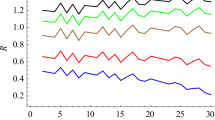Abstract
The microwave Zebra pattern structure is an intriguing fine structure on the dynamic spectra of solar type IV radio bursts. Up to now, there is no perfect physical model for the origin of the solar microwave Zebra pattern. Recently, Ledenev et al. (Sol. Phys. 233:129, 2006) put forward an interference mechanism to explain the features of microwave Zebra patterns in solar continuum events. This model needs a structure with a multitude of discrete narrow-band sources of small size. Based on the model of a current-carrying plasma loop and the theory of tearing-mode instability, we propose that the above structure does exist and may provide the main conditions for the interference mechanism. With this model, we may explain the frequency upper limit, the formation of the parallel and equidistant stripes, the superfine structure and intermediate frequency drift rate of the Zebra stripes. If this explanation is valid, the Zebra pattern structures can reveal some information of the motion and the inner structures of the coronal plasma loops.
Similar content being viewed by others
References
Alfven, H., Carlqvist, P.: Sol. Phys. 1, 220 (1967)
Altyntsev, A.T., Kuznetsov, A.A., Meshalkina, N.S., Rudenko, G.V., Yan, Y.: Astron. Astrophys. 431, 1037 (2005)
Ashbourn, J.M.A., Woods, L.C.: Astrophys. J. 602, 1021 (2004)
Bennett, W.H.: Phys. Rev. 45, 90 (1934)
Chen, B., Yan, Y.H.: Sol. Phys. 246, 431 (2007)
Chernov, G.P., Yan, Y.H., Fu, Q.J.: Astron. Astrophys. 406, 1071 (2003)
Chernov, G.P., Yan, Y.H., Fu, Q.J., Tan, C.M.: Astron. Astrophys. 437, 1047 (2005)
Chernov, G.P., Yan, Y.H., Fu, Q.J., Tan, C.M., Wang, S.J.: Sol. Phys. 250, 115 (2008)
Chiuderi, C., Giachetti, R., Rosenberg, H.: Sol. Phys. 33, 25 (1973)
Drake, J.F., Swisdak, M., Che, H., Shay, M.A.: Nature 443, 553 (2006)
Dulk, G.A.: Ann. Rev. Astron. Astrophys. 23, 169 (1985)
Fomichev, V.V., Fainshtein, S.M.: Sol. Phys. 71, 1071 (1981)
Furth, H.P., Rutherford, P.H., Selberg, H.: Phys. Fluids 16, 1054 (1973)
Karlicky, M., Barta, M.: Astron. Astrophys. 464, 735 (2007)
Kuijpers, J.: Astron. Astrophys. 40, 405 (1975)
Kuijpers, J., van der Post, Slottje, C.: Astron. Astrophys. 103, 331 (1981)
LaBelle, J., Treumann, R.A., Yoon, P.H., Karlichy: Astrophys. J. 593, 1195 (2003)
Ledenev, V.G., Yan, Y., Q, Fu.: Chin. J. Astron. Astrophys. 1, 475 (2001)
Ledenev, V.G., Yan, Y., Fu, Q.: Sol. Phys. 233, 129 (2006)
Melrose, D.B.: Astrophys. J. 381, 306 (1991)
Melrose, D.B.: Astrophys. J. 451, 391 (1995)
Miller, J.A., Cargill, P.J., Emslie, A.G., Holman, G.D., Dennis, B.R., LaRosa, T.N., Winglee, R.M., Benka, S.G., Tsuneta, S.: J. Geophys. Res. 102, 14631 (1997)
Mollwo, L.: Sol. Phys. 83, 305 (1983)
Ning, Z., Yan, Y., Fu, Q., Lu, Q.: Astron. Astrophys. 364, 793 (2000)
Rosenberg, H.: Sol. Phys. 51, 188 (1972)
Slottje, C.: Sol. Phys. 25, 210 (1972)
Spicer, D.S.: Sol. Phys. 53, 305 (1977)
Tan, B.L.: Adv. Space Res. 39, 1826 (2007)
Tan, B.L.: Sol. Phys. 253, 117 (2008)
Tan, B.L., Huang, G.L.: Astron. Astrophys. 453, 321 (2006)
Tan, B.L., Yan, Y.H., Tan, C.M., Liu, Y.Y.: Astrophys. J. 671, 964 (2007)
Vlahos, L., Isliker, H., Lepreti, F.: Astrophys. J. 608, 540 (2004)
Winglee, R.M., Dulk, G.A.: Astrophys. J. 307, 808 (1986)
Zaitsev, V.V., Stepanov, A.V.: Sol. Phys. 88, 297 (1983)
Zheleznyakov, V.V., Zlotnik, E.Y.A.: Sol. Phys. 44, 461 (1975)
Author information
Authors and Affiliations
Corresponding author
Rights and permissions
About this article
Cite this article
Tan, B. A physical explanation of solar microwave Zebra pattern with the current-carrying plasma loop model. Astrophys Space Sci 325, 251–257 (2010). https://doi.org/10.1007/s10509-009-0193-5
Received:
Accepted:
Published:
Issue Date:
DOI: https://doi.org/10.1007/s10509-009-0193-5




